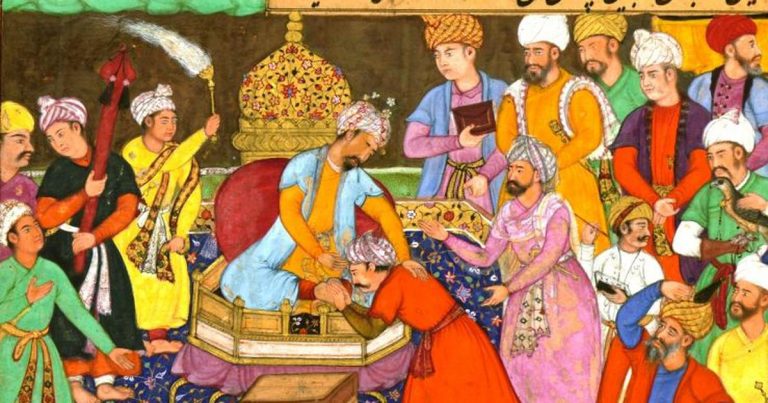
While the trade of slaves was not unknown in India, the scale of slavery in India was extremely small in pre-Islamic times.
By Shanmukh-Saswati Sarkar-Dikgaj-Aparna-Kirtivardhan
Indic mercantile dominance of slave economy of Islamic states outside India
Indic merchants controlled the economy of Musqat in Uman, a major center of trade of African slaves. They enjoyed close connection with the Muslim rulers of Masqat and influenced many of the policies of the Islamic state there. S. B. Miles reported the ruins of Hindu temple at Qalhat, the principal Umani port of the fifteenth century. The argument for fifteenth century settlement of Indic merchants in Musqat is supported is supported further by de Albuquerque’s report that Hindu merchants from Gujarat escaped from Khyr Fakkan, a secondary port on the Shimiliya coast of Northern Uman, before he sacked that town in 1507. Calvin H. Allen has written that “Oral traditions of the Indian merchant community in Musqat allege that these Sindis were the first ‘Banians’ to settle in Musqat and add that they were Bhattis (Bhattiya). Sindi Bhattias apparently thrived under the Portuguese rulers of Musqat. The Umani Chroniclers Ibn Ruzyaq and Al-salimi both report that a Banian ‘worshipper of the cow’ acted as supply agent for the Portuguese garrison at Musqat, and the Portuguese Commander seems to have accepted advice freely from his agent. However, the Banian eventually became dissatisfied with the Portuguese, especially as the commander wished to marry his daughter, and helped the Yaariba ruler of Uman expel the Europeans from Musqat in 1650. Bhattia support for the Yaariba proved to be very beneficial for the Banians. The community was exempted from paying the poll tax (Jizya) and permission was granted for the construction of a temple. ….The Hindu Community was not affected adversely by the civil war which established the Al Bu Said dynasty in the 1740s, and it continued to prosper under Ahmad b. Said (1743 – 82). In January 1765 the Danish explorer Carsten Niebuhr spent two weeks at Musqat and has left the following description of the Banian community: “In no other Mahometan city are the Banians so numerous as in Mascat; their number in this city amounts to no fewer than 1200. They are permitted to live agreeably to their own laws, to bring their wives hither, to set up idols in their chambers, and to burn their dead.” The Indic mercantile influence on the oppressive Islamic state of Musqat was so significant that they were even allowed to found four Hindu places of worship.
Sindi Bhattias apparently thrived under the Portuguese rulers of Musqat.
In 1836 the Arabian traveler J. R. Wellsted described the Hindu community of Musqat, Uman, as constituting ‘a body of the principal merchants’ of that port. Kutchi Bhattias dominated the trade and economic affairs of the port of Musqat, expanding their control in two stages, separated by Said b. Sultan’s transfer of his residence to Zanzibar after 1830. A few Kutchi Bhattias rose to prominence in the service of the commercially mind Sayyid Said. Family legend claims that Gopal’s (Mawji Bhimani) great-grandfather was the first Bhimani to trade in Musqat late in the 18th century. In time, the family founded a business in Musqat, and Gopal Bhimani began to play an active role in Masqati politics. Gopal was among the Banians who encouraged Said b. Sultan to conquer Zanzibar. Once settled in Zanzibar, Said b. Sultan started selling slaves and cloves. During his extended absences in East Africa he delegated most of Masqat’s commercial affairs in the hands of resident Bhattias. Both the treasurer and chief customs official were Kutchi Bhattias, and it was likely at this time that the practice of farming the Musqati customs was instituted, and the Kutchis began to pour into this port. By 1840 the Banian population had reached 2000, and, as stated by Wellsted, the community had become the principal economic power in Musqat. The Kutchi Bhattias flourished in Musqat during the reign of Thuwayni b. Said (1865-68). They continued to control the treasury and customs house, and accrued the profits that had earlier filled the coffers of the ruling family. By the 1870s the Indian merchants dominated the commercial life of Musqat and had replaced the Al Bu Said rulers of the town at the paramount economic power in Uman. Most of them lived and worked in Musqat within the walled portion of the city and close to the Sultan’s Palace. The Hindus celebrated their religious festivals, such as New Year (Divali), with social gatherings and dinner parties. Typically a dish of the best food would be taken to the Sultan. Banians were also invited to the palace on special occasions, although they would not eat the food prepared by the ruler’s non-Hindu cooks.
The Banians were the leading bankers of Musqat and in due course came to own large land holdings there due to mortgage foreclosures. For example, early in the 1880s Shet Ratansi Purshottam Purecha began to acquire land along the waterfront of Muscat and eventually came to own all the waterfront property with the exception of the palace, customs house and British political agency. This was only one of the many parcels of land that he came to own, and by the end of the 19th century he and his Banian colleagues owned bulk of the best property in Musqat and Matrah.
During the late 19th century, Shet Ratansi became a leading arms merchant. He dealt with the London firm Schwarte and Hammer and the Hamburg arms dealer Moritz Magnus, and was active in exporting dates to the United States through the New York Forum of William hills (now a subsidiary of Nabisco). The leading bankers of a major slave economy would inevitably fund the slave trade. (Concludes)
___________________
Courtesy: Myind.net
Click here for Part -I , Part-II, Part-III, Part-IV